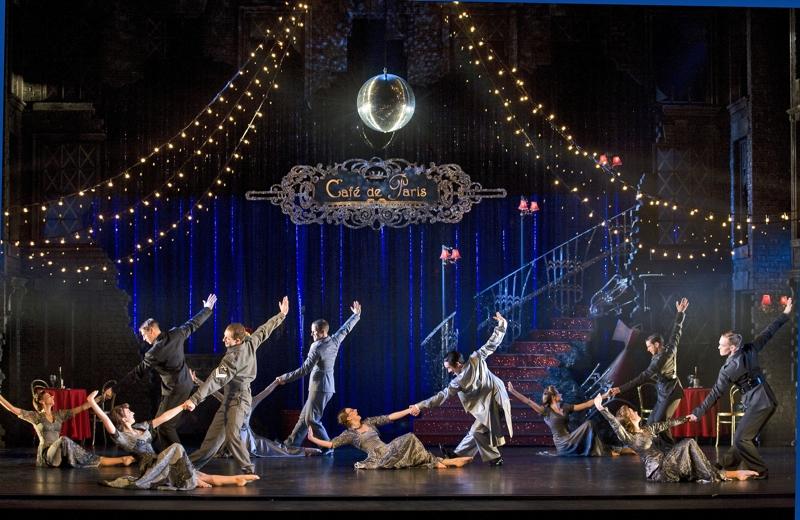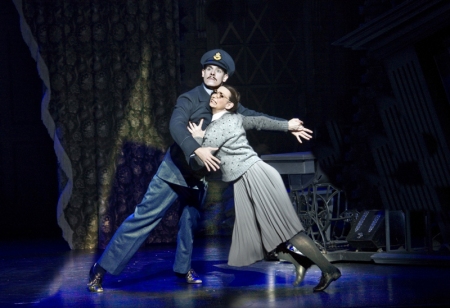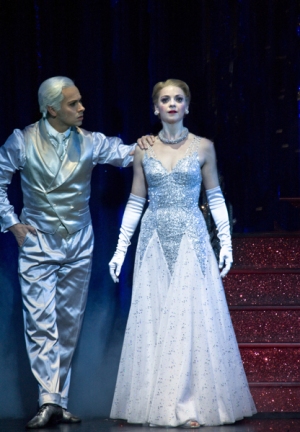Matthew Bourne's Cinderella, Sadler's Wells | reviews, news & interviews
Matthew Bourne's Cinderella, Sadler's Wells
Matthew Bourne's Cinderella, Sadler's Wells
Fairy tale in wartime London: and Bourne's finest hour

What a stunning show Matthew Bourne has created in his Blitz-era Cinderella - truly a magical ride created from what was in its original 1997 form a pumpkin waiting to be transformed. This must be the most heartwarming and sophisticatedly rewarding Christmas show in London, filled with a huge love of the city and a moving homage to humanity in wartime.
The beauty of Bourne’s thinking is that Cinderella could be anyone, she’s been picked out by a white-clad Angel, to be freed from an oppressed life and allowed to find happiness. There are many echoes of old weepie movies: the Angel (a nicely sly, otherworldly Christopher Marney) and the wounded pilot who catapults out of the sky hint at A Matter of Life and Death, the deliciously feelgood finale at Paddington station rights the sad wrong done to railway stations in Brief Encounter, and surely Cinderella’s twinkling shoes awoke at least a little flicker of The Red Shoes in Bourne’s imagination.
Set, music, drama and choreography seem perfectly intertwined, the masterstroke being the sound experience, with bombs and sound atmosphere recorded into the music to create what's practically a film score, and making one watch and sense the stage in a fresh and new way. Lez Brotherston’s set is a virtuosic evocation of black-and-white Forties movies into which, as love and hope blossom, lighting designer Neil Austin floods the colours of the Union Jack, rich blue, arresting red and a soft golden ivory. Over it all hangs a faint projection of the twisted London skyline of St Paul's which adds the sense (along with the sound manipulations) that you the spectator have been plunged back in time.
There is a sensationally realised Act Two set for a bombed and wrecked Café de Paris, which - before your disbelieving eyes - runs backwards and reassembles for the action before once again disintegrating, with even more impact. The dingy grey townhouse where Cinderella lives has already been damaged by war, the mantelpiece slips dangerously, the grey brick walls are shattered at the sides. Her dad is a First World War casualty, it seems, barely sensate in a wheelchair, a figure of mockery for his black-hearted Cruella de Ville of a wife, the glorious Michela Meazza, eyecatching in fabulous Galliano-type outfits (one hat is an upturned stiletto shoe), with all the poisonous glamour of Joan Crawford at her meanest.
 The two stepdaughters are her pallid clones, while Cinderella (the very sweet Noi Tolmer last night) is a dumpy teenager in woolly grey school uniform with thick glasses whose dreams turn a dressmaker’s dummy into almost Mr Right (pictured right, Kerry Biggin and Sam Archer). A large and pleasing assortment of awkward silly-ass chaps are part of the circle, stepbrothers and various boy and girlfriends, who generate both some nice comedy and the generational gap in dance styles, their jitterbug being interrupted by Stepmother insistent on teaching them the tango. It’s one of many incidental examples of Bourne’s musical responsiveness to what sometimes appear in other dance versions of the Prokofiev to be problems.
The two stepdaughters are her pallid clones, while Cinderella (the very sweet Noi Tolmer last night) is a dumpy teenager in woolly grey school uniform with thick glasses whose dreams turn a dressmaker’s dummy into almost Mr Right (pictured right, Kerry Biggin and Sam Archer). A large and pleasing assortment of awkward silly-ass chaps are part of the circle, stepbrothers and various boy and girlfriends, who generate both some nice comedy and the generational gap in dance styles, their jitterbug being interrupted by Stepmother insistent on teaching them the tango. It’s one of many incidental examples of Bourne’s musical responsiveness to what sometimes appear in other dance versions of the Prokofiev to be problems.
One might feel that Bourne's contemporary dance style is stretched too far in Act Two, but again and again I felt like saying, “Yes!” as he used a little musical phrase with perfect impact to introduce an action or start a new incident. Cinderella wears a glorious dress (pictured below, Kerry Biggins with Christopher Marney as The Angel), but basically she's dancing with squaddies and ordinary Londoners, not with heroes. This is arrestingly so in the so-called “seasons” numbers of Act One and in Act Three, whose music is often cut by ballet choreographers. Bourne’s thoroughly absorbed the moods of the music, as well as its programmatic associations, and with Paul Groothuis’s superb aural enhancements he’s delivered and underlined both the nightmarish terror lurking in the score and its deep soulfulness.
 The sounds of war correlate directly to Prokofiev’s own experience, and it’s profoundly moving to have the bleakness turned into images, and therefore the tenderness and yearning of some of those melodies emerge even more keenly. The wounded pilot’s character is only fully revealed in a clever moment at the end (he and the father have had identical experiences), but his shellshocked roaming through a blasted and terrified London provides some marvellous scenes that make Prokofiev’s music shine in a brilliant new chiaroscuro. The hectic “autumn” music becomes a frightening pursuit by what seem to be ravenous dogs, men in snout-shaped gasmasks. The wanderings of Act The is a lost, scary peregrination by the wounded man through a hellish London, assaulted by prostitutes and pimps in Oxford Circus Tube and on Waterloo Bridge, every incident scrupulously finding a new musical insight.
The sounds of war correlate directly to Prokofiev’s own experience, and it’s profoundly moving to have the bleakness turned into images, and therefore the tenderness and yearning of some of those melodies emerge even more keenly. The wounded pilot’s character is only fully revealed in a clever moment at the end (he and the father have had identical experiences), but his shellshocked roaming through a blasted and terrified London provides some marvellous scenes that make Prokofiev’s music shine in a brilliant new chiaroscuro. The hectic “autumn” music becomes a frightening pursuit by what seem to be ravenous dogs, men in snout-shaped gasmasks. The wanderings of Act The is a lost, scary peregrination by the wounded man through a hellish London, assaulted by prostitutes and pimps in Oxford Circus Tube and on Waterloo Bridge, every incident scrupulously finding a new musical insight.
As does the playing itself on this unique recording - this is a vivid and involving interpretation, and it turns out to be by Bourne’s own trusty band of players under Brett Morris, who have consistently delivered top standards in all his shows live. They won’t mind, I hope, if I say this is their finest hour, because their playing has an excitement, drive and detail in this embellished recording that wouldn’t have been possible live from the pit and will make many of us listen to Prokofiev’s music with freshly sensitised ears.
How far Bourne has come since 1997, when this Cinderella seemed to be the potentially great show that had somehow got away. Much more a character piece than a ballet rendition, that Cinderella didn’t evince 10 years ago the full stage command for all its characters. But since then Bourne’s mastered and expanded his skills with the brilliant Play Without Words and his other popular productions. If Swan Lake was an acutely rewritten evocation of one man's soul, Cinderella is a love letter to the London that survived the war, a deeply felt expression of confidence in humanity. This is a magnificent show, and Bourne’s finest hour.
- Matthew Bourne's Cinderella is at Sadler's Wells until 23 January, 2011
Explore topics
Share this article
Add comment
The future of Arts Journalism
You can stop theartsdesk.com closing!
We urgently need financing to survive. Our fundraising drive has thus far raised £49,000 but we need to reach £100,000 or we will be forced to close. Please contribute here: https://gofund.me/c3f6033d
And if you can forward this information to anyone who might assist, we’d be grateful.

Subscribe to theartsdesk.com
Thank you for continuing to read our work on theartsdesk.com. For unlimited access to every article in its entirety, including our archive of more than 15,000 pieces, we're asking for £5 per month or £40 per year. We feel it's a very good deal, and hope you do too.
To take a subscription now simply click here.
And if you're looking for that extra gift for a friend or family member, why not treat them to a theartsdesk.com gift subscription?
more Dance
 'We are bowled over!' Thank you for your messages of love and support
Much-appreciated words of commendation from readers and the cultural community
'We are bowled over!' Thank you for your messages of love and support
Much-appreciated words of commendation from readers and the cultural community
 R:Evolution, English National Ballet, Sadler's Wells review - a vibrant survey of ballet in four acts
ENB set the bar high with this mixed bill, but they meet its challenges thrillingly
R:Evolution, English National Ballet, Sadler's Wells review - a vibrant survey of ballet in four acts
ENB set the bar high with this mixed bill, but they meet its challenges thrillingly
 Like Water for Chocolate, Royal Ballet review - splendid dancing and sets, but there's too much plot
Christopher Wheeldon's version looks great but is too muddling to connect with fully
Like Water for Chocolate, Royal Ballet review - splendid dancing and sets, but there's too much plot
Christopher Wheeldon's version looks great but is too muddling to connect with fully
 iD-Reloaded, Cirque Éloize, Marlowe Theatre, Canterbury review - attitude, energy and invention
A riotous blend of urban dance music, hip hop and contemporary circus
iD-Reloaded, Cirque Éloize, Marlowe Theatre, Canterbury review - attitude, energy and invention
A riotous blend of urban dance music, hip hop and contemporary circus
 How to be a Dancer in 72,000 Easy Lessons, Teaċ Daṁsa review - a riveting account of a life in dance
Michael Keegan-Dolan's unique hybrid of physical theatre and comic monologue
How to be a Dancer in 72,000 Easy Lessons, Teaċ Daṁsa review - a riveting account of a life in dance
Michael Keegan-Dolan's unique hybrid of physical theatre and comic monologue
 A Single Man, Linbury Theatre review - an anatomy of melancholy, with breaks in the clouds
Ed Watson and Jonathan Goddard are extraordinary in Jonathan Watkins' dance theatre adaptation of Isherwood's novel
A Single Man, Linbury Theatre review - an anatomy of melancholy, with breaks in the clouds
Ed Watson and Jonathan Goddard are extraordinary in Jonathan Watkins' dance theatre adaptation of Isherwood's novel
 Peaky Blinders: The Redemption of Thomas Shelby, Rambert, Sadler's Wells review - exciting dancing, if you can see it
Six TV series reduced to 100 minutes' dance time doesn't quite compute
Peaky Blinders: The Redemption of Thomas Shelby, Rambert, Sadler's Wells review - exciting dancing, if you can see it
Six TV series reduced to 100 minutes' dance time doesn't quite compute
 Giselle, National Ballet of Japan review - return of a classic, refreshed and impeccably danced
First visit by Miyako Yoshida's company leaves you wanting more
Giselle, National Ballet of Japan review - return of a classic, refreshed and impeccably danced
First visit by Miyako Yoshida's company leaves you wanting more
 Quadrophenia, Sadler's Wells review - missed opportunity to give new stage life to a Who classic
The brilliant cast need a tighter score and a stronger narrative
Quadrophenia, Sadler's Wells review - missed opportunity to give new stage life to a Who classic
The brilliant cast need a tighter score and a stronger narrative
 The Midnight Bell, Sadler's Wells review - a first reprise for one of Matthew Bourne's most compelling shows to date
The after-hours lives of the sad and lonely are drawn with compassion, originality and skill
The Midnight Bell, Sadler's Wells review - a first reprise for one of Matthew Bourne's most compelling shows to date
The after-hours lives of the sad and lonely are drawn with compassion, originality and skill
 Ballet to Broadway: Wheeldon Works, Royal Ballet review - the impressive range and reach of Christopher Wheeldon's craft
The title says it: as dancemaker, as creative magnet, the man clearly works his socks off
Ballet to Broadway: Wheeldon Works, Royal Ballet review - the impressive range and reach of Christopher Wheeldon's craft
The title says it: as dancemaker, as creative magnet, the man clearly works his socks off
 The Forsythe Programme, English National Ballet review - brains, beauty and bravura
Once again the veteran choreographer and maverick William Forsythe raises ENB's game
The Forsythe Programme, English National Ballet review - brains, beauty and bravura
Once again the veteran choreographer and maverick William Forsythe raises ENB's game

Comments
...
...
...